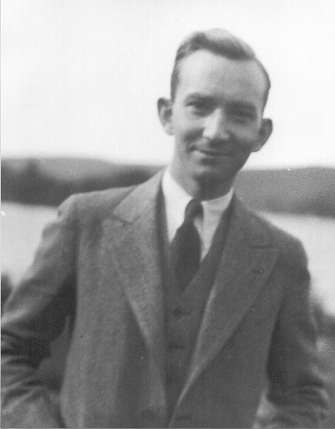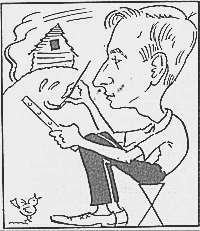
W. Flood
1904 - 1946 |
A Summary Chronology
The Life of Wilfrid Flood
from the writings of his
son John (2000-03-10)
Early Years in England:
Wilfrid "Bill" John Flood was born
in Dalston, England on 17 January 1904, the second of three children.
During his lifetime he spelled his name "Wilfrid", although his birth certificate
shows his name as actually being spelled "Wilfred". Even as a child
in Clapton, England, Wilfrid won several awards for his artwork.
In 1919, at the age of 14, he won the princely sum of one pound one shilling
from the London Daily Sketch. In early 1924, |
Wilfrid applied his artistic expertise
while working on an exhibit in the Wembley Room at the War Office, which
was later exhibited at the British Empire Exhibition. Wilfrid attended
the Bolt Court School of Art on Fleet Street in London.
The Move to Canada:
He immigrated to Canada in May
1924 and settled in Ottawa. "Bill"
worked as a draughtsman and cartographer
for the National Research
Council, Department of Mines and
Resources, Gauge Laboratory.
Wilfrid continued to develop his
artistic style in such mediums as: water colour; oil paintings; portraits,
charcoal, pastel; pencil drawings copper etching. He was known to
illustrate for small books and periodicals, such as "Hysteric Histories"
by Drew Thompson,"Northland Trails" by Sidney Clark Ells, "The Romance
of Canada" by A.L. Burt (a book used by Canadian High Schools to teach
history), and contributed numerous maps and sketches to the Canadian Geographical
Journal between 1936 and 1939.
Artistic friends and Companions:
Wilfrid was a constant companion
of Henri Masson, Dr. Maurice Haycock, Capt. George Pepper, Tom Wood, David
Westwood and L.H.S. Pereira. Wilfrid also associated with the Group
of Seven, including A.Y. Jackson and Frederick Varley, from whom he purchased
a painting in 1938 to help Frederick, who was in dire straits at that time.
During the 1930's, he painted under the tutelage of Franklin Brownell,
R.C.A., and Ernest Fosbery, R.C.A.,and Frederick Varley. According
to his wife Henriette, Wilfrid and Henri were invited to join the Group
of Seven, but graciously declined for unknown reasons.
Portraits of Canadian Personages:
During the 1930's and 1940's, Wilfrid
produced many paintings,
usually of landscapes, his first
love. However, he was also an
outstanding portrait artist, painting
such notables as Henri Masson,
Sir William Clark (the British
High Commissioner to Canada), Lawrence
J. Burpee (first editor of the
Canadian Geographical Journal), and
Sidney Clark Ells (a noted geologist
and author).
Exhibitions during his Lifetime:
Wilfrid's paintings have
been exhibited at the National Gallery of Canada, the
Montreal Museum of Fine Arts, the
Art Gallery of Ontario, the Royal
Canadian Academy of Arts, during
the Art Association of Ottawa Annual
Spring Exhibitions, the James Wilson
Galleries of Ottawa, the
Willestead Art Gallery in Windsor,
the Arnot Art Gallery in Elmira,
New York, several local Ottawa
art galleries and exhibits.In 1939, one of Wilfrid's paintings, "Storm
Over Farrelton", was selected by the National Gallery of Canada to be exhibited
at the New York World's Fair, one of 88 paintings by 53 Canadian artists
represented, including paintings by the Group of Seven.
Memberships and Associations:
Wilfrid was a long-time member
of the Ottawa Art Club and served as
President from 1932-1934, and was
a member of the executive
(Secretary) of the Art Association
of Ottawa from 1933 until his
death in 1946. He was a founding
member and instructor, along with
Henri Masson, of the Ottawa association
of painters known as "Les
Confreres du Caveau". Wilfrid
was elected to the Ontario Society of
Artists (OSA) in 1942, and was
a member of the Canadian Society of
Painters in Water Colour (CSPWC)
and the Canadian Society of Graphic
Artists (CSGA). Wilfrid was
also a founding member and first
Secretary of the Ottawa branch
of the Federation of Canadian Artists
(FCA) founded by Henri Masson in
1945.
National Archives of Canada Collection:
Five of Wilfrid's paintings are
housed in the National Archives of
Canada, three of which are portraits
of Henri Masson in pastel and
water colour, and two of Sidney
Clark Ells in charcoal and pencil.
Artistic Donations:
In 1940, Wilfrid donated two paintings
to the Committee for Refugees;
the paintings "Maples at Maberley"
and "Sunday Afternoon, Val des Bois",
were subsequently sold at a charity
auction at the National Art
Gallery. Their whereabouts
are unknown at this time.
An Untimely Death:
On 28 March 1946, shortly after
giving a speech to the "Wrangler's
Club" at the Chateau Laurier, Wilfrid
collapsed and died from a heart
attack His heart had been
weakened as a child during a bout of
rheumatic fever. He was buried
at the Notre Dame Cemetery following
a funeral mass at St. Margaret
Mary's church in Ottawa. Canada lost
one of her outstanding artists
at the young age of 42.
Memorial Exhibit:
In March/April 1947, a memorial
exhibit of paintings by Wilfrid Flood
was presented at the Photographic
Stores' Little Gallery on Sparks
Street in Ottawa. He was
eulogized in the promotional pamphlet by
Henri Masson. At that time,
many paintings were sold, and their
whereabouts are unknown to this
day, although several have been
traced to their owners. From
that time forward, nothing has been
publicized about his paintings,
and they sat in a closet for 52 years
until late 1998, when his wife
Henriette passed away.
==============================================
The following article was written for
the National Research Council's Newsletter, "The Neutron". The date
of the article is unknown.
=====================================================
|

|
"In this article,
the first of a series, we wish to call attention to the fact that there
are persons who possess talent in fields other than their bread-and-butter
occupations. It is true that persons with
multiple talents are rather rare
but several of these unusual people are nevertheless working right here
in the National Research Laboratories. One of these is Wilfrid (Bill)
Flood, of the Gauge Laboratory, who also happens to be one of Canada's
outstanding artists. |
Born in London,
England, Bill Flood came to Canada in 1924. His boyhood hobby of
sketching, which he developed at the Bolt Court School of Art in London,
had already reached partial maturity. In Ottawa he pursued his studies
under Franklin Brownell, R.C.A., and Ernest Fosbery, R.C.A.. Flood's
unique skill and versatility with palette and brush have been recognized
by layman and artist alike, and he now holds prominent membership in the
Ontario Society of Artists, the Canadian Society
of Painters in Water Colour, and
the Canadian Society of Graphic Art.
Flood's work
covers a wide range: landscapes in water colour and oil, portraits
in oil and pastel, and delightful pictographs in black and white, all reveal
an artist of exceptional calibre. Emotion and imagination are both
mirrored in his paintings, but the essence of Bill Flood's work is his
strength of purpose and sincerity of mind which lie exposed upon his canvases."
======================================================
| Memorial
Article March 1947 |
MEMORIAL EXHIBITION OF WILFRID FLOOD'S ART
By W.M. Arnott March 1947
The loss sustained
by Canadian Art in the death of Wilfrid J. Flood is well demonstrated in
the memorial exhibition of his work at the Little Gallery, 65 Sparks Street.
The exhibition opened yesterday and continues through to April 19.
Flood's intensely
contemplative style is strongly evident in most of his water colours in
which quiet grays predominate. There are a few who view his productions
who are not at once impressed by his calmness. Masson says of Flood:
"Always kind and patient" and these qualities are evident in his water
colours - and, to a lesser degree, in his oils.
CHARACTERISTIC WORK
Characteristic
of Flood's like for quiet colours is his "Landscape Near Farm Point", "Pines
at Hazledean" and this same predilection shows in many of the paintings
on exhibition. The showing of work covers a number of years and shows
very clearly the growing strength of his work; His growing tendency
to use high lights of colour and to depart, to some extent, at least, from
the traditional English water colour school of which has was an adherent.
Perhaps nothing
shows more clearly the trend of Flood's later work than his very fine "Alexandra
(Interprovincial) Bridge". It carries a vivid sense of motion, and
has very definite realism, yet is dramatic in scope. While it has
the Flood hallmark of gray colouration, it is also highlighted with colour
and shows clearly that Flood was launching out vigorously into a new and
stronger method of interpretation.
That he did not
disdain colour is demonstrated in "Covered Bridge, La Salette", a warmly-toned
picture, full of reflected light, and carrying that fine draftsmanship
that was always evident in his paintings.
The exhibition
carries his "Tabac Canadien", "Dry Summer Corn, Blue Sea", well-known to
all lovers of Flood's work. And to those who appreciated his Northern
paintings there is his "Mine Shaft at Cobalt", a painting that brings a
warm glow to any who knew the "Silver Square" in the famed "Silver City".
"Early Morning,
Northern Lake" is another water colour that reminds of lazy days spent
along the Mississauga or other points where Flood loved to roam. That Flood
was increasingly leaning toward brighter colours is shown in his "Haystack
Near Alcove"
in which the yellows of the stack
combine pleasantly with the purple-blues of the hills, and the deeper tones
of the autumn trees. "Hayfield, Cowley Road" and "Old Pines, Mount
St. Patrick" also show his careful and selective handling of colours.
OIL PAINTINGS
But it is in
his oils that his use of colour shows up predominantly. "The Red
Mill" should be viewed. The vivid red of the mill building makes
a most effective foil for the blue of the mill pool and the surrounding
landscape. A gem of draftsmanship, a picture full of delicacy yet
replete with colour is his "Ste. Rose de Lima" and there is a small view
of the same church that is delightful.
Other oils well
worth viewing include "October, Mountain Road", "Early Spring", "August
Evening" and the "Fire Station in Hull", while in the window is "The Red
School, Hull" an outstanding Flood oil that shows clearly the heights toward
which Flood was moving when death overtook him and quenched his genius.
| Toronto
Globe and Mail 1942 |
MOST POPULAR PICTURE IN GRAPHIC ARTS SHOW
The Toronto Globe and Mail, 1942
Results of the
public voting on pictures in the Graphic Arts section in the displays
just closed at the Art Gallery of Toronto, are announced.
Most popular picture
was a charcoal drawing by Wilfrid Flood, of Ottawa, called "Mile 20",
depicting a railway track. Runner-up was an entry by E. Lindner
of Saskatoon. The professionals' choice was the tempra white drawing
"Sabotage," of Miller Brettain, St. John, N.B. Two-thirds of the
950 ballots distributed were returned.
|